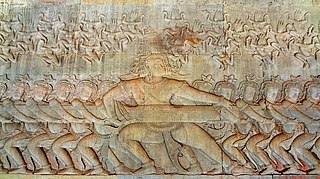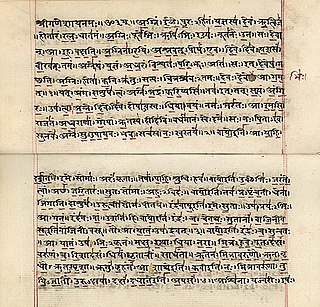Related Research Articles

The Kama Sutra is an ancient Indian Hindu Sanskrit text on sexuality, eroticism and emotional fulfillment in life. Attributed to Vātsyāyana, the Kama Sutra is neither exclusively nor predominantly a sex manual on sex positions, but rather was written as a guide to the art of living well, the nature of love, finding a life partner, maintaining one's love life, and other aspects pertaining to pleasure-oriented faculties of human life. It is a sutra-genre text with terse aphoristic verses that have survived into the modern era with different bhāṣyas. The text is a mix of prose and anustubh-meter poetry verses. The text acknowledges the Hindu concept of Purusharthas, and lists desire, sexuality, and emotional fulfillment as one of the proper goals of life. Its chapters discuss methods for courtship, training in the arts to be socially engaging, finding a partner, flirting, maintaining power in a married life, when and how to commit adultery, sexual positions, and other topics. The majority of the book is about the philosophy and theory of love, what triggers desire, what sustains it, and how and when it is good or bad.
Prithvi, also rendered Pṛthvī Mātā, is the Sanskrit name for the earth, as well as the name of a devi (goddess) in Hinduism of the earth and some branches of Buddhism. In the Vedas, her consort is Dyaus, the sky god. Her Puranic equivalent is known as Bhumi, the consort of Varaha.

Asuras are a class of beings in Indian religions. They are described as power-seeking demons related to the more benevolent Devas in Hinduism. In its Buddhist context, the word is translated as "titan", "demigod", or "antigod".

In Indian religions, a rishi is an accomplished and enlightened person. They find mentions in various Vedic texts. Rishis are believed to have composed hymns of the Vedas. The Post-Vedic tradition of Hinduism regards the rishis as "great yogis" or "sages" who after intense meditation (tapas) realized the supreme truth and eternal knowledge, which they composed into hymns. The term appears in Pali literature as Ishi; in Buddhism they can be either Buddhas, Paccekabuddhas, Arahats or a monk of high rank.

Angiras or Angira was a Vedic rishi (sage) of Hinduism. He is described in the Rigveda as a teacher of divine knowledge, a mediator between men and gods, as well as stated in other hymns to be the first of Agni-devas. In some texts, he is considered to be one of the seven great sages or Saptarishis, but in others he is mentioned but not counted in the list of seven great sages. In some manuscripts of Atharvaveda, the text is attributed to "Atharvangirasah", which is a compound of sage Atharvan and Angira. The student family of Angira are called "Angira", and they are credited to be the authors of some hymns in the first, second, fifth, eighth, ninth, and tenth books of the Rigveda. By the time of the composition of the Rigveda, the Angirases were an old Rishi clan, and were stated to have participated in several events.

Puranas are a vast genre of Hindu literature about a wide range of topics, particularly about legends and other traditional lore. The Puranas are known for the intricate layers of symbolism depicted within their stories. Composed originally in Sanskrit and in other Indian languages, several of these texts are named after major Hindu gods such as Vishnu, Shiva, Brahma, and Adi Shakti. The Puranic genre of literature is found in both Hinduism and Jainism.
Dasa is a Sanskrit word found in ancient Indian texts such as the Rigveda, Pali canon, and theArthashastra. The term may mean "slave", "enemy" or "servant," but Dasa or Das can also have the following connotations: "servant of god", "devotee," "votary" or "one who has surrendered to God." Dasa may be a suffix of a given name to indicate a "servant" of a revered person or a particular deity.
Hindu texts or Hindu scriptures are manuscripts and voluminous historical literature which are related to any of the diverse traditions within Hinduism. Some of the major Hindu texts include the Vedas, the Upanishads, and the Itihasa. Scholars hesitate in defining the term "Hindu scriptures" given the diverse nature of Hinduism, but many list the Agamas as Hindu scriptures, and Dominic Goodall includes Bhagavata Purana and Yajnavalkya Smriti in the list of Hindu scriptures as well.
Sayana was a 14th-century Sanskrit Mimamsa scholar from the Vijayanagara Empire of South India, near modern day Bellary, Karnataka. An influential commentator on the Vedas, he flourished under King Bukka Raya I and his successor Harihara II. More than a hundred works are attributed to him, among which are commentaries on nearly all parts of the Vedas. He also wrote on a number of subjects like medicine, morality, music and grammar.

Deva means "shiny", "exalted", "heavenly being", "divine being", "anything of excellence", and is also one of the Sanskrit terms used to indicate a deity in Hinduism. Deva is a masculine term; the feminine equivalent is Devi. The word is a cognate with Latin deus ("god") and Greek Zeus.

Wendy Doniger O'Flaherty is an American Indologist whose professional career has spanned five decades. A scholar of Sanskrit and Indian textual traditions, her major works include The Hindus: An Alternative History; Asceticism and Eroticism in the Mythology of Siva; Hindu Myths: A Sourcebook; The Origins of Evil in Hindu Mythology; Women, Androgynes, and Other Mythical Beasts; and The Rig Veda: An Anthology, 108 Hymns Translated from the Sanskrit. She is the Mircea Eliade Distinguished Service Professor of History of Religions at the University of Chicago, and has taught there since 1978. She served as president of the Association for Asian Studies in 1998.

The Vedas are a large body of religious texts originating in ancient India. Composed in Vedic Sanskrit, the texts constitute the oldest layer of Sanskrit literature and the oldest scriptures of Hinduism.
In Hindu mythology, Sarama is a mythological dog being referred to as the female dog of the gods, or Deva-shuni. She first appears in one of Hinduism's earliest texts, the Rig Veda, in which she helps the king of the gods Indra to recover divine cows stolen by the Panis asuras. This legend is alluded to in many later texts, and Sarama is often associated with Indra. The epic Mahabharata, and some Puranas, also make brief reference to Sarama.

The Vishnu Purana is one of the eighteen Mahapuranas, a genre of ancient and medieval texts of Hinduism. It is an important Pancharatra text in the Vaishnavism literature corpus.
Vedic metre refers to the poetic metre in the Vedic literature. The study of Vedic metre, along with post-Vedic metre, is part of Chandas, one of the six Vedanga disciplines.

Vladimir Nikolayevich Toporov was a leading Russian philologist associated with the Tartu-Moscow semiotic school. His wife was Tatyana Elizarenkova. He is also recognized as a prominent Balticist.
In Hinduism, Rishabha is one of the twenty-four avatars of Vishnu in the Bhagavata Purana. Some scholars identify this avatar to be the same as the first tirthankara of Jainism, Rishabhanatha. Shaiva texts like the Linga Purana regard Rishabha to be among the 28 avatars of Shiva. Rishabha is also found in Vedic literature, where it means the "bull" and is an epithet for Rudra (Shiva).
Kalpa means "proper, fit" and is one of the six disciplines of the Vedānga, or ancillary science connected with the Vedas – the scriptures of Hinduism. This field of study is focused on the procedures and ceremonies associated with Vedic ritual practice.

The Rigveda or Rig Veda is an ancient Indian collection of Vedic Sanskrit hymns (sūktas). It is one of the four sacred canonical Hindu texts (śruti) known as the Vedas. Only one Shakha of the many survive today, namely the Śakalya Shakha. Much of the contents contained in the remaining Shakhas are now lost or are not available in the public forum.

Agni is the Hindu god of fire. and the guardian deity of the southeast direction, he is typically found in southeast corners of Hindu temples. In the classical cosmology of Hinduism, fire (Agni) is one of the five inert impermanent elements (Pañcabhūtá) along with sky (Ākāśa), water (Apas), air (Vāyu) and earth (Pṛthvī), the five combining to form the empirically perceived material existence (Prakṛti).
References
- Elizarenkova, Tatyana J. (1995), Language And Style Of The Vedic Rsis, Albany: State University of New York Press